After the
countdown dinner for the Atascosa Highlands CBC at Widsom’s Café in Tumacacori, I set out
for another night of roadside camping, finding a spot barely 9 ½ miles west of
where I had camped last night. This would be my 10th and final
Christmas Bird Count this season, on January 3. There are two more days to the
CBC season after this, and indeed there is one CBC on each of the remaining two
days, but both are hours away in central and eastern Arizona, and the weather
forecast is looking very unfavorable, especially at those high elevations.
Tonight, here in the southeastern corner of the state, it is calm once again –
even calmer than last night – and only in cold pockets of stagnant air is it
dipping below freezing. Thank goodness for my new Exped thermal sleeping mat. I
am quite cozy and stir only often enough to enjoy the continual hooting Great
Horned Owls, tooting Western Screech-Owls, and packs of singing Coyotes.
There are
but 2.13 miles separating the nearest boundaries of this CBC circle and the
Atascosa Highlands CBC circle to the SE, but it’s amazing how different the two
are. This one has no spectacular canyons, mountain cliffs, shady draws, or
southward-draining watersheds. All we have to deal with here are low rolling
foothills and broad valleys. As a result, there are no Whiskered Screech-Owls
in this circle, and I hear only the same two species during my two hours of
owling that I’ve been hearing all night. But both are calling everywhere, and I
end up the morning with 11 Great Horned Owls on my list; at one point I
carefully counted six separate individuals audible from one spot.
Dawn was a
flurry of sparrow and towhee chipping and squeaking, but I was able to tease
out several species by their call notes, as well as Bewick’s Wrens, Verdins,
and Crissal Thrasher. I heard what I was pretty sure were call notes of
Cassin’s Sparrow, and some playing of the song indeed resulted in some very
aggressive responses. Throughout the day I would try the same just by guessing
at the habitat and almost always received a response. This individual ended up
being the first of an amazing 17 Cassin’s Sparrows that I would tally today.
I then birded
some by car along the Tres Bellotas road south of Arivaca, and on one of my
first stops had a pair of Hepatic Tanagers. There are just barely enough oaks
in this area to make this almost an expected rarity for here, but these turn
out to be the first ever in 30 years of this CBC’s existence. I got a good shot
of the male.
I’m helping
to cover the only part of the circle that has any oaks, and the patches are
sparse, but just enough for some of the oak specialists such as Bushtit and
Bridled Titmouse.
Another oak
specialist that is missable on this CBC is the Hutton’s Vireo. I have no doubt
that this unusual species is a mimic Ruby-crowned Kinglet.
Here is a
Ruby-crowned Kinglet that responded unusually aggressively to my pishing and
owl imitations. In fact these three photos were successive shots as I held the
camera’s shutter button down, which takes about 3 photos per second. They never
sit still, and it’s amazing I was able to get it in the frame and in the right
focal plane. To compare it with the vireo, notice the thin bill, thin legs,
golden toes and black legs (rather than all bluish gray), the stronger lower
pale wing bar (not two evenly bright wing bars), and the additional dark bar on
the primaries. But the overall color, size, shape, and especially that eyering
broken at the top are uncannily similar.
This Black
Phoebe responded to one of my mobbing sessions.
With 271
individuals tallied, Chipping Sparrow was the most abundant species on my route
today.
I had only a
few Black-chinned Sparrows, a bird usually missed on this CBC.
A Rock Wren
was a slightly odd sight on the tip of a tree.
After
birding by car for a few hours, I reached the limit of my rental car’s
clearance and hiked down upper San Luis Wash for about 3 ½ miles, returning by
the road. It was mostly desert grassland with a good diversity of shrubs and
trees close to the riparian area.
Activity of
honeybees brought me to inspect this apparently lifeless shrub.
It was in
fact in full bloom – Forestiera shrevei,
Desert Olive. It’s in the family Oleaceae, the same as olive, ash (Fraxinus), and lilac.
Everywhere I
walked there were Rufous-winged Sparrows. At one point I had about 10 in one
bush, but mostly there were pairs separated by only 10-20 yards. When I covered
this same area with Fabrice Schmitt two year ago, we had a respectable 28
Rufous-winged Sparrows. Even 10 would be good. This year I finished covering my
area with an astounding 142 individuals.
I had a few
Pyrrhuloxias and Northern Cardinals in the riparian thickets.
There was
one stretch of the wash were taller hackberry-mesquite-acacia woodland extended
some 50 yards either side of the main channel in a more subtropical fashion.
And indeed
here I discovered a pair of Black-capped Gnatcatchers, the first ever for this
CBC.
The Netleaf
Hackberries in this woodland were a food source for a lot of birds, including
this Crissal Thrasher. They had obviously been quite fecund in the previous
breeding season or two, as I tallied 26 this day.
On my way
back to the car, I walked through more upland mesquite desert scrub, but I
continued to hear and flush pairs and groups of Rufous-winged Sparrows here.
But the more open habitat was preferred by Black-throated Sparrows. Any other
year in the past 150 years this species would have outnumbered Rufous-wingeds,
but today I found only 44.
Bewick’s
Wrens had a spectacular breeding year, and I found 50, well over the averge
number this count gets from all group. Cactus Wrens were not so abundant; I
found only 11.
My last new
bird of the day was this gorgeous black morph Red-tailed Hawk, species #56.

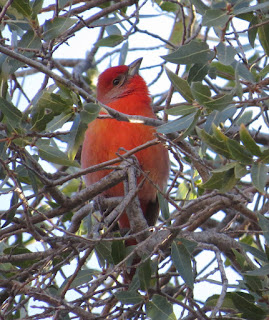

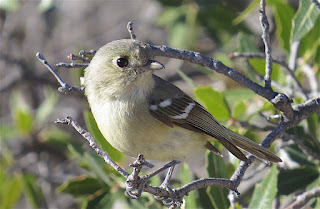








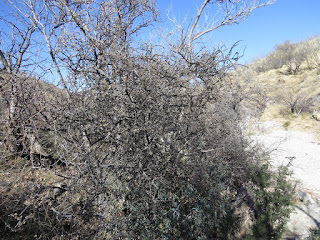
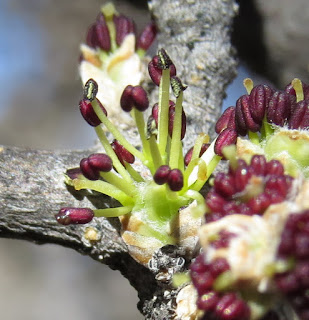


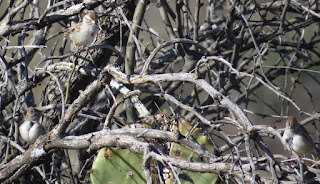














No comments:
Post a Comment